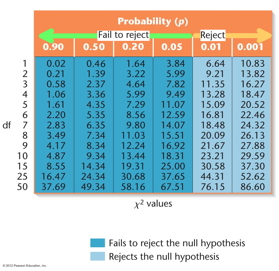Department of Biological and Environmental Sciences
Genetics
Dr. David A. Johnson
Biol 333 4 Credits Spring 2017 MWF 8:00-9:05 AM PH 204
Probability and Statistics
|
A Quick Overview of Probability and Statistics in Genetics: Probability and statistics are used to analyze genetic data and to predict outcomes. In predicting the outcome of a cross, first ask yourself, "What gametes (and in what proportion) do the parents make?"
*Binomial Expansion in Genetics The expansion of a binomial
equation (from algebra) is used to calculate the
probability of multiple outcomes in genetics. A
binomial equation is the sum of two numbers raised
to a power, like:
(p+q)2 or (p+q)3 If you remember your basic algebra, (p+q)2 = (p+q)x(p+q) = p2 + 2pq + q2 Similarly (p+q)3 = p3 + 3p2q + 3pq2 + q3 and (p+q)4 = p4 + 4p3q + 6p2q2 + 4pq3 + q4 or in general: (p+q)n = pn + c1pn-1q + c2pn-2q2 + c3pn-3q3 + ... + qn So, the expansion of the binomial is simply arrived at by writing the factor with p raised to the nth power (for example, 4th power for (p+q)4), plus p raised to the (n-1) power times q, plus p raised to the (n-2) power times q2, etc., until you get to the last factor qn. Now, to find the coefficients of each factor (c1, c2, c3, etc.), use Pascal's Triangle. |
probstat_files/css3menu17/bhome.png) Home
Homeprobstat_files/css3menu17/podiuml.png) Lectures
Lecturesprobstat_files/css3menu17/256base-save-over.png) Online
Onlineprobstat_files/css3menu17/bnews.png) Tests
Testsprobstat_files/css3menu17/256-1.png) Extra
Extra